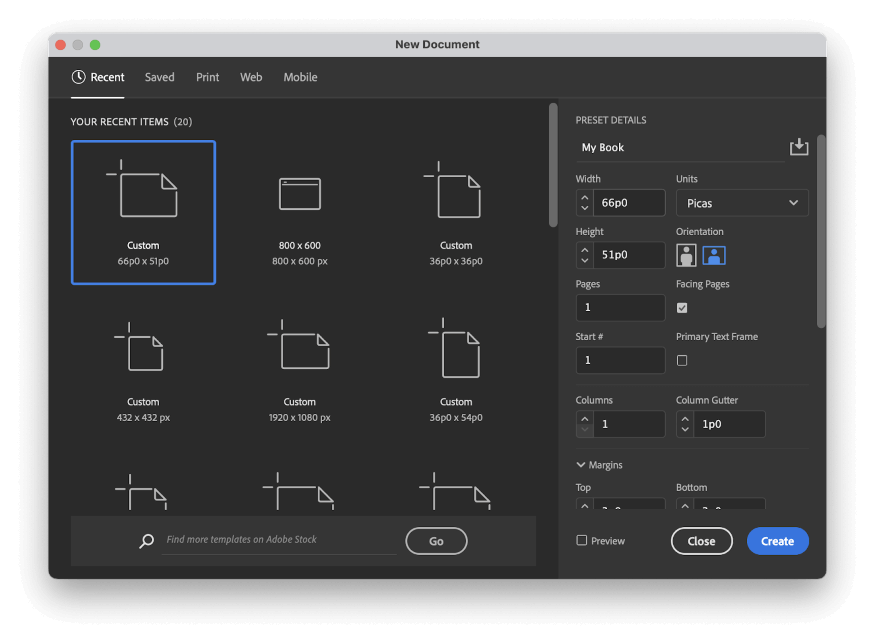One of the most important aspects of any book design project is selecting the final size of your book. Also known as the “trim size”, choosing the correct size for your book can make a huge difference in its page count – and its success.
Larger book sizes are often more expensive to produce and are typically priced much higher for the consumer, but a smaller book that has a very high page count can quickly become just as expensive.

If you’re lucky enough to be working with a publisher, they’ll probably want to determine the trim size of your book using their own methods, but self-publishers don’t have the luxury of a marketing department.
If you’re planning on designing and typesetting your book by yourself, always be sure to check with various printing services before starting the design process to ensure that they can accommodate you.
Table of Contents
Standard Paperback Book Sizes
Here are the most popular paperback book sizes in the United States. Paperback books are typically smaller, lighter, and cheaper than hardcover books (both to produce and to purchase), although there are exceptions to the rule. Most novels and other types of fiction use the paperback format.
Mass-Market Paperbacks
- 4.25 inches x 6.87 inches
Also known as a pocketbook, this is the smallest standard paperback book size used in the United States. These paperbacks are the cheapest standard format to produce and as a result, they have the lowest price point for consumers.
Typically, they are printed using cheap ink and lightweight papers with a thin cover. As a result of this cheap appeal, they are often sold outside of bookstores in supermarkets, airports, and even gas stations.
Trade Paperbacks
- 5 inches x 8 inches
- 5.25 inches x 8 inches
- 5.5 inches x 8.5 inches
- 6 inches x 9 inches
Trade paperbacks come in a range of sizes from 5”x8” to 6”x9”, although 6”x9” is the most common size. These paperbacks are usually produced at a higher quality level than mass-market paperbacks, using heavier paper and better inks, although the covers are still generally thin.
The cover art on trade paperbacks sometimes features specialized inks, embossing, or even die cuts to help them stand out on the shelf, although this can add to the final purchase price.
Standard Hardcover Book Sizes
- 6 inches x 9 inches
- 7 inches x 10 inches
- 9.5 inches x 12 inches
Hardcover books are more expensive to produce than paperbacks due to the additional cost of printing and binding the cover, and as a result, they often use larger trim sizes. In the modern publishing world, the hardcover format is mostly used for non-fiction, although there are some special fiction editions that prioritize quality over mass pricing appeal.
Additional Book Formats
There are a number of other popular standard book sizes, such as those used in the world of graphic novels and children’s books. Textbooks, manuals, and art books don’t really have a standard size, since their individual content often determines the trim size requirements.
Graphic Novels & Comic Books
- 6.625 inches x 10.25 inches
While graphic novels aren’t totally standardized, many printers suggest this trim size.
Children’s Books
- 5 inches x 8 inches
- 7 inches x 7 inches
- 7 inches x 10 inches
- 8 inches x 10 inches
Due to the nature of the format, children’s books can vary widely in their final trim size, and many even use completely custom shapes to help hold the attention of younger audiences.
FAQs
Many authors who self-publish agonize over the process of selecting the right book size, so I’ve included a couple of the most popular questions that are asked on the subject.
What is the most popular book size?
According to Amazon, which is the largest book retailer in the entire world, the most common book size in the United States is 6” x 9” for both paperback and hardcover books.
How should I choose a book size/trim size?
If you’re self-publishing your book, there are several basic considerations to take into account when selecting a trim size. First and foremost, make sure that your printer can handle the trim size that you’re thinking of using.
Next, consider the impact of your trim size on your page count, since most printers will charge an extra fee per page when it extends beyond a predefined limit. Finally, balance those two requirements against the final price you plan to charge your customers.
If you’re in doubt, just choose a trim size of 6”x9” and you’ll be in good company with many other best-selling books – and you’ll also have no trouble finding a printer that can handle the creation of your masterpiece.
A Final Word
That covers the basics of standard book sizes in the US market, although readers in Europe and Japan may find that the standard book sizes vary from what they’re used to.
Perhaps the most important advice when it comes to book sizes is that you should always check with your printer before going ahead with a lengthy design process. Time is money, and it can quickly become expensive to update your document layout to match a new page size after it’s already been designed.
Happy reading!
